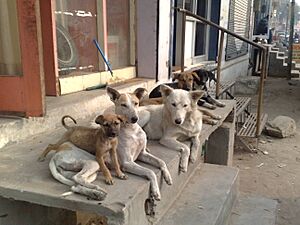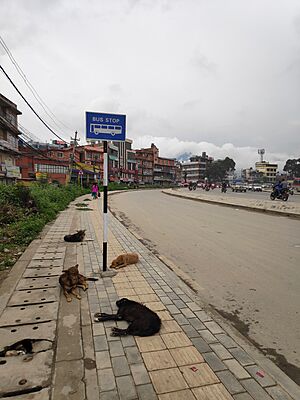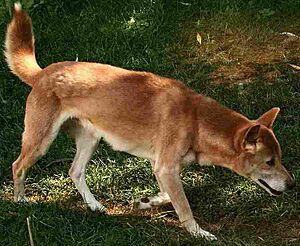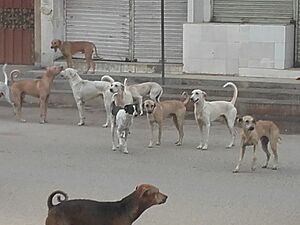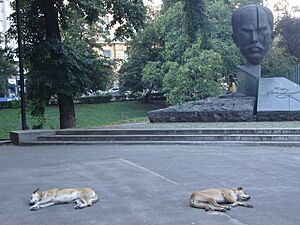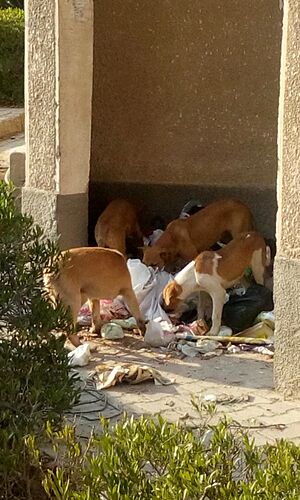Free-ranging dog facts for kids
A free-ranging dog is a dog that roams freely and isn't kept in a yard or house. These dogs include street dogs, village dogs, stray dogs, and feral dogs. Some might have owners, while others don't. There are about 900 million dogs worldwide. Only about 20% of these are pets kept by owners.
You'll find many free-ranging dogs in developing countries. For example, India has about 62 million of them. They are less common in Western countries, but you can still find them in parts of Eastern and Southern Europe. Free-ranging dogs can spread diseases like rabies, especially where the disease is common. Many groups, including governments and animal rights organizations, work to manage these dogs around the world.
Contents
What Are Free-Ranging Dogs?
Dogs have lived with humans for a long time. But sometimes, dogs lose contact with people and live on their own. This has happened throughout history.
Most dogs in developing countries are not pets. They often live as scavengers, finding their own food. When approached by strangers, they usually run away. We know less about these dogs than we do about pet dogs. Most studies on dog behavior focus on dogs living in human homes.
Why Dogs Become Strays
Stray dogs are dogs without an owner. Sometimes, the term "stray dog" means a lost pet. But generally, it means any unowned dog that roams freely. Organizations like Four Paws say strays are either born on the streets or abandoned by owners.
Several things can lead to dogs becoming strays:
- Some dogs are born on the streets and have never had an owner. They live in a wild or semi-wild state.
- Other dogs were once pets but were abandoned. Owners might abandon puppies if they can't care for a litter.
- Owners might also abandon dogs due to money problems, changes in their lives, or health issues.
- Sometimes, working dogs are abandoned if their owners are unhappy with their performance.
- Dogs can also become strays after natural disasters or conflicts.
Different Types of Dogs
It can be confusing to talk about different types of dogs. Dogs can be grouped by whether they have an owner, how much they can move around, and if they are genetically different from other dog groups.
Owned Dogs
Owned dogs are "family" dogs. They have a clear owner and are usually friendly with people. They are not allowed to roam freely. They stay in specific outdoor or indoor areas. These dogs usually don't affect wildlife unless they go into natural areas with their owners.
Domestic dogs include all dog breeds (except dingoes). Humans have chosen to breed, keep, and feed them. They can be pets, guard dogs, or working dogs. Even domestic dogs can act wild if they are not controlled or are allowed to roam freely.
Free-Roaming Owned Dogs
A free-ranging dog is one that isn't kept in a yard or house. Free-ranging owned dogs have an owner or a community of owners. But they are allowed to roam freely. This group includes "village dogs" that live in rural areas and near human homes. They are not confined but usually stay near their village.
It also includes "rural free-ranging dogs." These dogs are owned or linked to homes but are not confined. This can include farm dogs that roam over certain areas.
Free-Roaming Unowned Dogs
Free-ranging unowned dogs are stray dogs. They find their own food and shelter from human environments. They usually avoid humans because they haven't been socialized.
This group includes "street dogs" that live in cities. They have no owner and survive on leftover food, garbage, or food from other dogs. Free-ranging unowned dogs also include feral dogs.
Feral Dogs
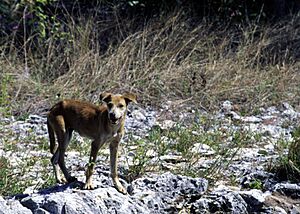
The term "feral" describes animals that were once domesticated but have returned to a wild state. Being "domesticated" (meaning a species can live with humans) is different from being "socialized" (meaning an individual animal is tame). A domesticated animal can be feral and not tame. A wild animal can be socialized to live with humans.
Feral dogs are different because they didn't have much human contact when they were young. They live in a wild state, finding their own food and shelter. They strongly avoid direct human contact. The difference between feral, stray, and free-ranging dogs can be small. A dog's status might change during its life.
Sometimes, a feral dog that wasn't born wild can become a pet. A dog becomes a stray if it escapes human control, is abandoned, or is born to a stray mother. A stray dog can become feral if it's forced away from humans or joins a feral group. Feral dogs develop a fear of humans. They don't reproduce enough on their own and many young dogs die. They depend on humans indirectly for food and space.
Are There "Wild" Dogs?
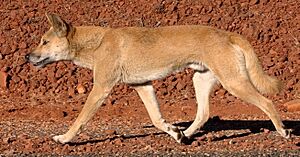
People debate if "wild dogs" truly exist. Some say the Australian dingo and dingo-feral dog hybrids are wild dogs. They believe these dogs have lived independently from humans for a long time. Others disagree, saying the dingo was once domesticated and is now feral.
The Queensland Department of Agriculture and Fisheries calls any dog that is not domesticated a "wild dog." This includes dingoes, feral dogs, and hybrids. Young wild dogs often travel more than 100 kilometers from where they were born.
When the first British settlers arrived in Australia in 1788, they saw dingoes living with indigenous Australians. Dingoes live in the wild but also associate with humans. They haven't been selectively bred like other domesticated animals. The dingo's relationship with indigenous Australians is like commensalism. This means two living things live closely without depending on each other for survival. They might hunt and sleep together. Dingoes are comfortable enough around humans to associate with them, but they can still live on their own, much like a domestic cat. Any free-ranging unowned dog can be socialized to become an owned dog, just as some dingoes join human families.
Another idea is that domestication is hard to define. It suggests dogs are either socialized (can live with humans) or unsocialized. Some dogs live with human families but are unsocialized. They might act aggressively towards strangers, like a wild wolf. There are also cases where wild wolves have approached people in remote areas, trying to play and form friendships.
Street Dogs in Cities
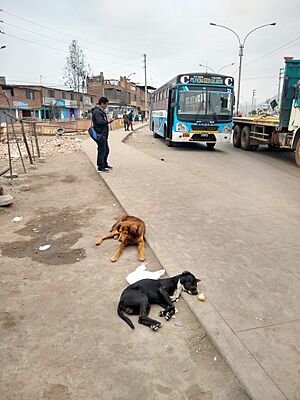
Street dogs, also called free-ranging urban dogs, are unconfined dogs that live in cities. You can find them almost everywhere cities exist, especially in the developing world. Street dogs might be former pets that got lost or were abandoned. Or they might be feral animals that have never had an owner. They can be purebreds, mixed-breed dogs, or local breeds like the Indian pariah dog.
Too many street dogs can cause problems for cities. So, campaigns to spay and neuter them are sometimes done. Street dogs are different from rural free-ranging dogs in their skills and how they interact with people.
In Paraguay in 2017, Diana Vicezar started a group to help abandoned dogs and deal with plastic pollution. Volunteers built shelters for dogs using recycled materials. By 2019, this idea had spread to other countries and involved 1000 people.
Problems Caused by Street Dogs

Dog Bites
Street dogs usually try to avoid conflict with humans to survive. However, dog bites and attacks can happen. Dogs might bite if they are scared, surprised, feel threatened, or are protecting something important like their puppies or food. Bites can also happen if dogs are sick, injured, hungry, or have been abused. Dogs might also bite due to their instincts to protect their territory or hunt.
Rabies is a serious problem in some countries. In India, with about 62 million free-ranging dogs, there are about 17.4 million animal bites each year. This leads to about 20,565 human deaths from rabies. India accounts for 36% of all rabies deaths worldwide.
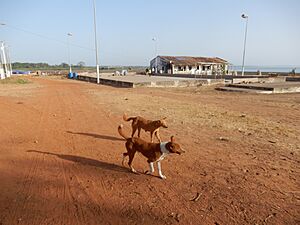
Besides rabies, dog bites can cause other health issues. These include infections like Capnocytophaga canimorsus, MRSA, and tetanus. Dog bites need immediate medical attention. After a bite, a tetanus vaccine might be needed if the person hasn't been vaccinated. Doctors might also give antibiotics for high-risk wounds. Deaths from dog bites are more common in lower-income countries.
Impact on Quality of Life
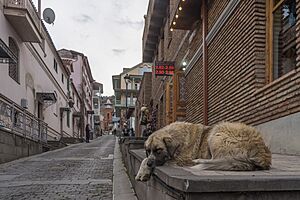
Many stray dogs can affect how people live. Barking, howling, and dog fights can disturb people, especially at night. Also, the fear of dog bites and attacks can make people anxious. It can also stop them from going outside or moving around freely.
Stray dogs' lives are also greatly affected by humans. They often struggle to find enough food and water. They are also at risk of abuse and neglect. Without medical care, they suffer from injuries and diseases. City environments can be tough and stressful for them. Encounters with humans can cause fear, injuries, and displacement.
Skills and Adaptations
Dogs are very adaptable and smart animals. Free-ranging dogs often form packs. To survive in cities, street dogs must learn to navigate traffic.
Some stray dogs in Bucharest have been seen crossing large streets at pedestrian crosswalks. The dogs likely noticed that cars stop when humans cross at these markings. They have learned the flow of people and cars. They wait patiently with people at the curb for a red light. Then they cross with them, knowing cars will stop.
In other countries, street dogs have reportedly used subway and bus services.
Dog Behavior
Free-ranging dogs are often crepuscular animals. This means they are most active at dawn and dusk. They are often inactive during the day, especially in hot weather. They commonly form packs. Dogs rest near their resource sites in their territory. They choose spots where they can see their surroundings well. For sleeping, they often pick central areas in their territory with shade. Dogs look for places that protect them from bad weather. They often rest or sleep under parked cars.
Free-ranging dogs that have lived this way for many generations have developed certain traits. These traits help them survive in their environments through natural selection.
Wild dogs rest during the day, often near water. Their paths to and from resting or den sites can be well-defined. They are usually shy and don't often go into cities unless encouraged. Dogs that were recently pets or have regular contact with people might approach homes. Wild dogs are drawn to places where they can find food. Feeding them, even by accident, can make them dependent on humans.
Wild dingoes in remote areas live in packs, usually 3–12 animals. A dominant male and female control breeding. Packs set up territories that usually don't overlap. Wild dogs, especially dingoes, regularly check the edges of their territory. This is called the dog's beat.
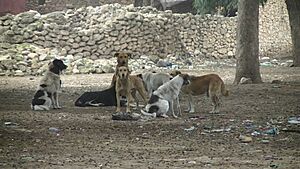
Wild dogs are often heard howling during breeding season. For pure dingoes, this happens once a year. Hybrid dogs have two breeding cycles each year.
After about nine weeks of pregnancy, four to six pups are born in a den. The den protects them from weather and other animals. Dens can be in soft ground under rocks, logs, or other hollows. Pups drink milk for 4–6 weeks and stop at four months. They become independent from their parents when they are 6 weeks to 2 months old. Pups that become independent later tend to survive better. More food from people also helps more pups survive to adulthood.
What Do They Eat?
According to the Queensland Department of Agriculture and Fisheries, wild dogs can be found on grazing land, near towns, in rural homes, or in forests. They live anywhere they can find food, water, and shelter. They will eat whatever is easiest to get when they are hungry, whether it's plants or animals. They will hunt live prey, or eat animals killed on roads, dead livestock, and scraps from compost heaps or trash.
They mostly hunt small prey like rabbits, possums, rats, wallabies, and bandicoots. When hunting in packs, they can take larger animals like kangaroos, goats, or young cattle and horses. What they eat most depends on what is common and easy to catch. They usually hunt in the early morning and early evening. They spot prey, approach quietly, and then chase them.
Wild dogs that rely mainly on trash might stay close to the trash source. Those that depend on livestock or wild prey might travel up to 20 kilometers. A study in Perth found that most of the 1400 dogs involved in livestock attacks were friendly family pets, not aggressive ones.
Rabies and Dogs
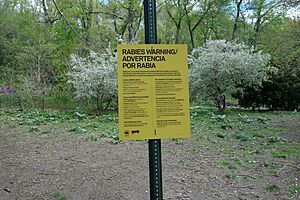
In 2011, an article said there were 200 million stray dogs worldwide. It also mentioned a "rabies epidemic" causing a global public health issue. In 2024, the World Health Organization reported that dog bites and scratches cause 99% of human rabies cases. About 40% of victims are children under 15. They also estimated about 59,000 human deaths from rabies each year, mostly in Asia and Africa.
Rabies cases have also happened in Europe. In 2012, a 5-year-old girl in Romania died after being bitten by a rabid stray dog. In the United States, rabies is mostly found in wildlife. However, in 2022, 50 dogs tested positive for rabies. In Africa, about 21,000–25,000 people die from rabies each year.
There have been discussions about whether children in areas with many free-ranging dogs should get preventative rabies vaccines. This is called pre-exposure prophylaxis (PrEP). While PrEP doesn't remove the need for post-exposure treatment after a bite, it makes that treatment simpler.
Some tourists from Western countries might not know about the rabies risk in other countries. In 2019, a woman from Norway died of rabies. She got the virus while on holiday in the Philippines after being bitten by a stray puppy she and her friends had rescued.
Impact on Wildlife
Large numbers of free-ranging dogs can be a threat to wildlife. Dogs have contributed to 11 animal extinctions. They are a known threat to 188 threatened species worldwide. This includes 96 mammal, 78 bird, 22 reptile, and 3 amphibian species. In cities, free-ranging dogs are often apex predators, meaning they are at the top of the food chain.
More free-ranging dogs are threatening snow leopards and young brown bears on the Tibetan Plateau. Dog packs chase these animals away from food. Free-ranging dogs can also carry diseases that can spread to humans. These include rabies, toxocariasis, and leptospirosis. They can also spread diseases like canine distemper and parvovirus to other dogs. These diseases can also jump to species like African wild dogs, wolves, lions, and tigers.
Additionally, free-ranging dogs can breed with other members of the Canis family. This includes the gray wolf, the Ethiopian wolf, and the dingo. They can even breed with animals outside their genus, like the pampas fox. This raises concerns about the purity of these wild animal populations.
A study from 2018-2020 found a wolf-dog hybrid in Romania's Southern Carpathian forests. The study noted that this discovery might seem small now. However, it could threaten the genetic purity of the wolf population in the long run. It suggested studying the problem of stray dogs entering wolf habitats.
See also


